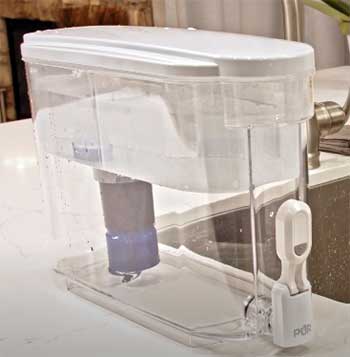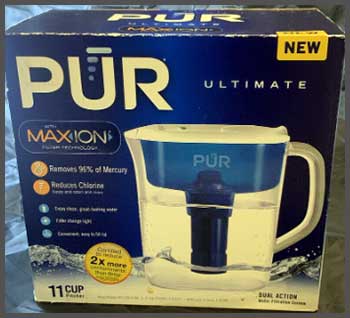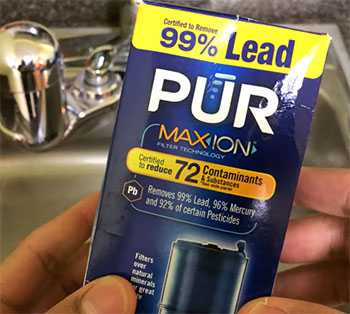When it comes to providing your household with safe, clean drinking water, making a choice between various water filter pitchers can be daunting. Two significant contenders in the market are the PUR PLUS and the PUR Maxion water filter pitchers.
Each of these units offers distinct features and benefits, but how do you determine which one is right for you?
Let’s take a deep dive into the specifics of the PUR PLUS and PUR Maxion water filter pitchers, evaluate their pros and cons, and help you make an informed choice.
A Brief Comparison Table
| Feature | PUR Plus | PUR Maxion |
| Filter Technology | Ion exchange, carbon filter | MAXION filter technology |
| Capacity | 40 gallons | 40 gallons |
| Certifications | NSF certified | NSF certified |
| Contaminants Removed | Lead, mercury, chlorine, pesticides | Lead, mercury, 97% of trace pharmaceuticals, chlorine, pesticides |
| Indicator Lights | Yes | Yes |
| BPA Free | Yes | Yes |
| Dimensions | 10.75 x 5.75 x 10.25 in | 10.75 x 5.75 x 10.25 in |
PUR PLUS Water Filter Pitcher: An Overview
The PUR PLUS Water Filter Pitcher stands out due to its sleek design and substantial filtering capabilities. The system uses an activated carbon filter with ion exchange resin to reduce common contaminants found in tap water, such as chlorine, mercury, and certain industrial pollutants.
Pros of PUR PLUS

- Superior Contaminant Reduction
The PUR PLUS stands out because of its capacity to reduce over 70 contaminants.
It is certified to reduce 2x more contaminants than Brita, which demonstrates its superior filtration ability.
- User-Friendly Design
With its comfort-grip handle and easy-fill lid, the PUR PLUS pitcher makes everyday use a breeze.
The pitcher’s CleanSensor Monitor also simplifies filter replacement by indicating when it’s time to change the filter.
Cons of PUR PLUS
- Filter Longevity
Although effective, the filters require relatively frequent replacement—every 1-2 months, based on your water usage. This could lead to extra maintenance costs over time.
PUR Maxion Water Filter Pitcher: An Overview
The PUR Maxion water filter pitcher utilizes Maxion Filter Technology, a unique blend of carbon and ion exchange material to reduce contaminants. This technology is PUR’s unique approach to tackling common and not-so-common water pollutants.
Pros of PUR Maxion
- Enhanced Filtration

The Maxion Filter Technology claims to reduce 3x more contaminants than Brita.
This includes not only typical contaminants like chlorine and mercury but also pharmaceuticals, certain pesticides, and industrial pollutants.
- Long-Lasting Filter
The PUR Maxion filter lasts up to 2-3 months, depending on usage.
This longevity could reduce the overall maintenance cost compared to the PUR PLUS.
Cons of PUR Maxion
- Larger Size
The PUR Maxion is a bit larger than the PUR PLUS, which might make it less convenient for those with limited fridge space.
Key Differences Between PUR PLUS and PUR Maxion Water Filter Pitchers
Although the PUR PLUS and PUR Maxion share a common goal of delivering cleaner, safer water, there are a few key differences that set these pitchers apart.
- Filter Technology
The biggest difference between these two pitchers is the filter technology itself. The PUR Plus uses a combination carbon block filter and ion exchange resin to remove contaminants. The PUR Maxion utilizes PUR’s proprietary MAXION filter technology.
The MAXION filter contains activated carbon made from coconut shells to filter water through adsorption. It also uses ion exchange to attract charged contaminant molecules. The key advantage of the MAXION filter is its selective ion exchange media, which targets specific trace pharmaceuticals.
The carbon block filter in the PUR Plus removes chlorine, metals like lead and mercury, microbes, and organics like pesticides and herbicides. The ion exchange resin reduces soluble heavy metals. It’s effective at contamination removal but doesn’t specifically target pharmaceuticals.
- Capacity
Both the PUR Plus and PUR Maxion pitchers have a 40 gallon capacity. This means each filter cartridge can effectively filter 40 gallons (or approximately 2 months worth) before needing replacement.
The pitchers themselves hold an ample 10 cups of water – enough to keep a family hydrated. The capacity is the same whether you choose the standard PUR Plus or the MAXION filter model.
- Certifications
The PUR Plus and PUR Maxion pitchers both meet NSF certification standards for the contaminant reduction claims stated on the packaging.
NSF/ANSI standards 42 and 53 certify the filter’s performance in removing aesthetic issues like chlorine as well as specific health contaminants like lead and mercury. The PUR Maxion also meets standard 401 for trace pharmaceutical removal.
You can feel confident both these pitchers’ filtration is backed by independent testing. The NSF mark of approval ensures the products live up to their claims.
- Contaminant Removal
One of the biggest differences between the PUR Plus and PUR Maxion is the range of contaminants reduced.

PUR Plus
The PUR Plus removes:
- Lead
- Mercury
- Chlorine taste and odor
- Microbial cysts
- Herbicides and pesticides
- 96% of pharmaceutical contaminants
PUR Maxion
The PUR Maxion reduces:
- Lead
- Mercury
- Chlorine
- Pesticides
- Microbes
- 97% of trace pharmaceuticals
The PUR Maxion’s MAXION technology gives it enhanced pharmaceutical removal, filtering 30+ medications to trace levels. These include common drugs like ibuprofen, progesterone, fluoxetine and others.
Both filters reduce metals, chlorine, microbes, and organics. But the PUR Maxion has a leg up when it comes to pharmaceuticals.
- BPA Free
The plastics used in both the PUR Plus and PUR Maxion pitchers are BPA free. Bisphenol A (BPA) is a chemical that can leach from certain types of plastic. Exposure may pose health risks.
Choosing a pitcher made from BPA free materials reduces the risk of chemical contamination in your drinking water. PUR uses safer, BPA-free plastic for all parts that come in contact with water.
- Dimensions
Since the PUR Plus and PUR Maxion use the same style pitcher, the dimensions are identical. Both pitchers measure:
- 10.75 inches tall
- 5.75 inches wide
- 10.25 inches deep
The sleek, slim profile allows them to fit conveniently in most fridge doors. They stand about 11 inches tall with the lid open.
At around 2 pounds empty, they are relatively lightweight when lifting and pouring. The curved ergonomic handle makes the pitchers easy to grip as well.
- Ease of Use
Both PUR models are simple to set up, use, and maintain:
- Set up – Remove packaging and wash pitcher. Run 1-2 full pitchers of water through to flush out filter.
- Fill – Fill through the wide opening lid. A fill line inside the reservoir indicates max capacity.
- Dispense – Water flows through the faucet by flipping the actuator. Close faucet between pours.
- Clean – Hand wash with mild detergent and warm water as needed.
- Replace – Swap filters when light indicates (approx. every 2 months)
The only difference in use comes from the filters themselves. The PUR Plus filter is all white, while the PUR Maxion has a chrome bottom section – but both drop easily into the reservoir.
- Cost Comparison

When comparing the ongoing cost of these two pitchers, the filters are the main factor since the pitchers themselves are the same price.
On average, the PUR Plus filters cost $7 per replacement cartridge. A pack of 3 costs around $20.
The PUR Maxion filters average about $9 per replacement. A 3-pack runs closer to $25.
Over the lifespan of the pitcher, the PUR Maxion would cost slightly more due to the higher cost of the MAXION technology filters. But the enhanced pharmaceutical filtration may make the extra cost worthwhile for some households.
- Filter Lifespan
While the PUR PLUS’s filter is quite effective, it requires relatively frequent replacement—every 1-2 months based on water usage. This regular upkeep may translate into additional maintenance costs over time.
In contrast, the PUR Maxion filter boasts a longer lifespan, lasting up to 2-3 months depending on usage. This longer lifespan could potentially lower overall maintenance costs compared to the PUR PLUS.
- Indicator Technology
The PUR PLUS pitcher comes equipped with a CleanSensor Monitor, an electronic filter indicator that tells you when it’s time to change the filter, adding to its convenience.
The PUR Maxion doesn’t have this feature, which means you’ll have to keep track of filter changes manually or observe any changes in the taste or smell of your water as indicators for replacement.
While both water filter pitchers share a common goal of purifying your water, their approaches differ. The PUR PLUS focuses on comprehensive contaminant reduction, while the PUR Maxion emphasizes advanced filtration technology and longer filter lifespan.
So, are the PUR and PUR PLUS interchangeable? In terms of basic function—filtering your water—they are. However, the specific contaminants they target and their filter lifespan differ, making them distinct options to consider based on your specific needs.
Frequently Asked Questions (FAQ)
While both the PUR and PUR PLUS are designed to reduce contaminants in your water, the PUR PLUS specifically targets over 70 contaminants and offers a user-friendly design.
In terms of basic function—yes, both purify your water. However, the specific contaminants they target and their filter lifespan differ, making them distinct options to consider based on your unique needs.
While the PUR Maxion can reduce many contaminants, it does not specifically claim to filter microbes like bacteria or viruses.
The PUR PLUS reduces over 70 contaminants, including chlorine, mercury, and certain industrial pollutants.
The PUR Maxion is among the best pitcher filters currently available due to its highly effective and unique MAXION filter technology that reduces trace pharmaceuticals.
Most consider the PUR Plus comparable or slightly better than Brita. PUR filters tend to have a longer lifespan. The PUR Plus also includes ion exchange resin for better removal of dissolved heavy metals.
Wrapping Up
To sum up, both the PUR PLUS and PUR Maxion water filter pitchers offer effective ways to ensure you’re getting clean, safe drinking water. Your choice between the two will depend on your specific needs, preferences, and how much you’re willing to spend on filter replacements over time.
As with any purchase, doing your research and understanding your requirements is the key to making the right decision.
